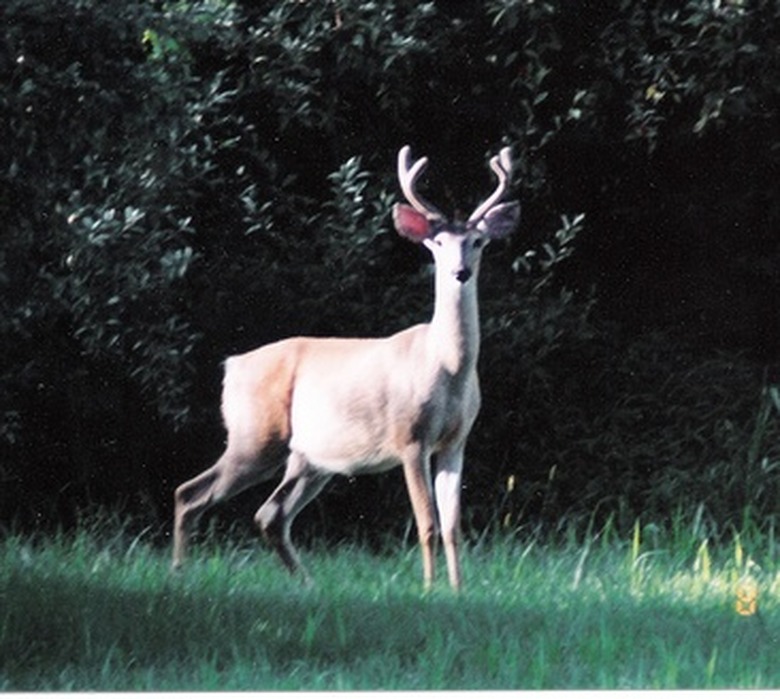Deer-Resistant Ornamental Grasses
While deer are attracted to all plants and grasses, there are ornamental grass options that rank highest as deer-resistant. If you are adding ornamental grass to a landscape exposed to visits by deer, plant a resistant variety to prevent heavy feeding and destruction. Identifying other habits and preferences of deer can help prevent damage to your garden from the animals.
While deer are attracted to all plants and grasses, there are ornamental grass options that rank highest as deer-resistant. If you are adding ornamental grass to a landscape exposed to visits by deer, plant a resistant variety to prevent heavy feeding and destruction. Identifying other habits and preferences of deer can help prevent damage to your garden from the animals.
Deer Grass Feeding
Deer feed on ornamental grasses during the spring and summer when they find their way onto residential landscapes looking for food. Once deer find a feeding ground, they devour plants they have an appetite for until there is nothing left to feed on. Characteristically, deer prefer open areas for browsing, or feeding. Human-created areas like gardens are ideal environments, according to the Oregon State University Extension Service. Deer have a preference for more than 500 plant varieties and can consume approximately 7 lbs of food per day. Planting deer-resistant ornamental grasses is your best option for protecting your landscape.
- While deer are attracted to all plants and grasses, there are ornamental grass options that rank highest as deer-resistant.
- If you are adding ornamental grass to a landscape exposed to visits by deer, plant a resistant variety to prevent heavy feeding and destruction.
Fescue Grass
Blue fescue (Festuca glauca) is a fescue grass rarely damaged by deer feeding, according to the Rutgers New Jersey Agricultural Experiment Station. The "Elijah Blue" variety of this ornamental is a clumping grass that displays an ice-blue hue and nude-colored flowers that bloom from May through June, according to the Washington State University Clark County Extension. Blue fescue is an evergreen widely used as ground cover or for borders that grows to a mound height and width of 12 inches. Plant this grass in full sun in USDA Hardiness Zones 4 to 8.
Japanese Blood Grass
Japanese blood grass (Imperata cylindrica) is an upright grass rarely damaged by deer, according to the Rutgers New Jersey Agricultural Experiment Station. A clumping ornamental plant, Japanese blood grass displays vivid green leaves with tips in a red color. Grass becomes a "blood red" color by autumn, according to the University of Illinois HortAnswers. Growing to a height of 1 to 2 feet, this deer-resistant ornamental grass thrives in full sun and moist or wet well-drained soils. Plant in USDA Hardiness Zones 5 to 9.
- Blue fescue (Festuca glauca) is a fescue grass rarely damaged by deer feeding, according to the Rutgers New Jersey Agricultural Experiment Station.
- The "Elijah Blue" variety of this ornamental is a clumping grass that displays an ice-blue hue and nude-colored flowers that bloom from May through June, according to the Washington State University Clark County Extension.
Fountain Grass
Fountain grass is deer-resistant, according to the Rutgers New Jersey Agricultural Experiment Station. This ornamental grass displays solid or variegated green, arched foliage that becomes yellow during the autumn season, according to the University of Illinois Extension HortAnswers. Fountain grass also produces pink/rose fuzzy flowers that turn red/brown. Growing to a height of 2 to 4 feet, fountain grass thrives in full sun and moist, well-drained soil. Plant in USDA Hardiness Zones 5 to 9.
Considerations
Since deer eat such a wide variety of plants and will revisit a location to graze on anything they can find, planting deer-resistant ornamental grass is a good solution, but only one part of the problem. If there are several other types of plants that deer are attracted to in your landscape, you will not be rid of your deer problem. If you have other plants that commonly attract deer, choose deer-resistant species for those planting choices, as well.
- Fountain grass is deer-resistant, according to the Rutgers New Jersey Agricultural Experiment Station.
- Since deer eat such a wide variety of plants and will revisit a location to graze on anything they can find, planting deer-resistant ornamental grass is a good solution, but only one part of the problem.
References
- Oregon State University Extension Service: Reduce Deer Damage in Your Yard
- Rutgers New Jersey Agricultural Experiment Station: Landscape Plants Rated by Deer Resistance
- Washington State University Clark County Extension: Blue Fescue
- University of Illinois Extension HortAnswers: Fountain Grass
- University of Illinois Extension HortAnswers: Japaenese Blood Grass
